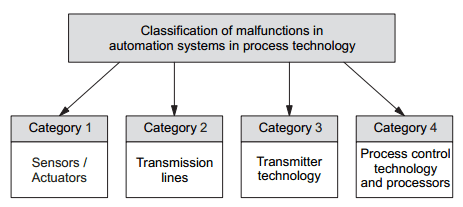Damage prevention training
Fault finding and error handling represents an extensive area of functions in a an operational technical process. A wide variety of errors can occur, which need to be analysed and eliminated by maintenance personnel. As far as a systematic grouping of these errors is concerned, Picture 1 defines different categories which are discussed below.
Picture 1: Classification of malfunctions in automation systems
Group 1 covers the typical errors, which are caused as a result of a failure of sensors or also non-operational actuators. Here, the following advice is given for error elimination:
Category 1
Sensor faults
>> Metrological checking immediately at the sensor terminals themselves or on the EMCS field terminal points.
Actuator faults
>> Testing of the incoming control signal on the actuator;
>> Testing directly on the actuator – signal path from the positioning to the servo drive (checking of calibrating accuracy);
>> Testing directly on the actuator – mobility of the valve poppet and spindle (error – e. g. as a result of jamming or rusting of valve poppet or spindle).
Category 2
Errors in transmission lines
>> Transmission measurements by means of checking of terminals on the EMCS field terminal points and process control console;
>> Visual checking of cable guides or cable trays (cable racks) to determine any mechanical damage.
Category 3
Errors in transmitter technology
>> Checking of input/output behaviour by applying defined input signals to the input terminals of the measuring transducer;
>> Checking of or repeating the calibration of the measuring transducer (checking of supply voltage).
Category 4
Errors on processors
>> Checking of supply voltages;
>> Checking of input/output signals according to allocations resulting from algorithm processing (e. g. off-line testing of PLC or compact controller).
Apart from the above mentioned typical errors on technical process systems, which can generally always be eliminated with the help of appropriate know-how, malfunctions can also occur, which may lead to damage of entire system complexes, including personal injury or at the very least serious danger. However, with the help of so-called damage prevention training, all system personnel are trained in how to react sensibly in the event, particularly of disaster, and to minimise any unavoidable material or personal damage. Doubtless, this damage prevention training is of particular importance in high risk installations (e. g. in atomic power stations, power stations, chemical plants, etc., but generally always needs to be adapted to the actual process technology.
A number of fundamental main points are listed below regarding the essence of damage prevention training:
>> First of all, the technical process system is to be broken down into important individual sections from the point of view of process technology and system safety.
>> Personnel are then to be completely familiarised with this structural breakdown (individual sections and their interaction), e.g. small-scale experimental module divided into the individual sections of filling level, flow and temperature control systems and supply module).
>> On the basis of the breakdown of the system structure, a strategy is to be developed for the isolation of individual technical process system sections. To this end, manual intervention (emergency intervention) with the help of the designed automation systems should be possible which, owing to the configuration of the transmission lines (e. g. stainless steel pneumatic lines), ensures a refractability of at least 1 to 2 minutes even in an emergency.
>> Personnel are to be trained in the handling of these emergency interventions.
>> Furthermore, appropriate fire extinguishing and other damage controlling devices are to be incorporated in the emergency operation training.
>> Finally, the most effective withdrawal of personnel from a damaged installation is to be defined and taught in the event of any damage occurring.
>> Personnel must also be given training in recognising any damage which has occurred as a result of an emergency (e. g. environmental damage), plus any other systems including personnel in danger, and in informing any other parties in close proximity as appropriate (to be evacuated) or to include these in the damage control.

No comments:
Post a Comment